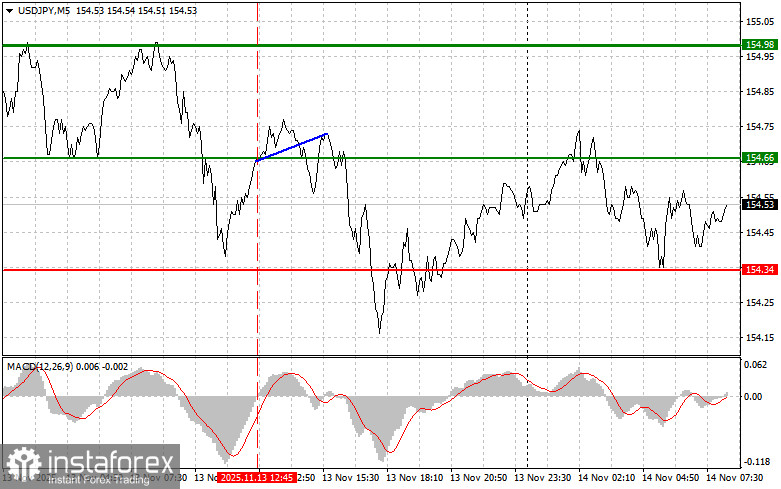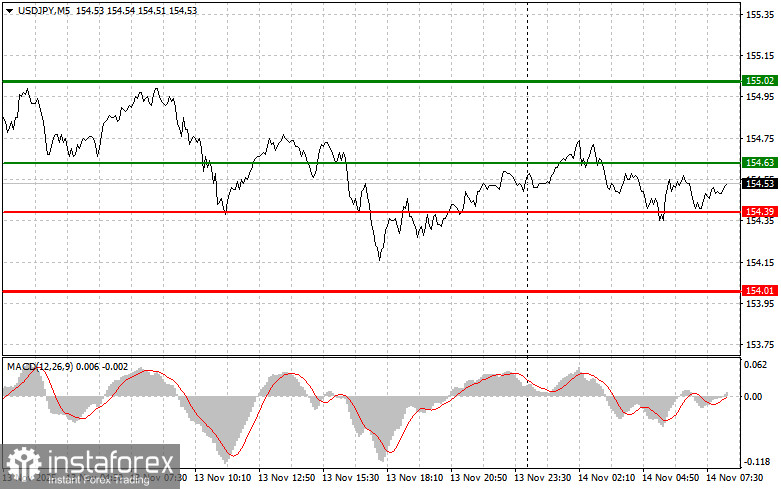Analysis of Transactions and Trading Tips for the Japanese Yen
The price test at 154.66 coincided with the MACD indicator just beginning to move up from the zero mark, which allowed buying the dollar in line with the trend. However, after a rise of 10 pips, pressure on the pair returned.
Despite a slight strengthening of the yen, Japan's economy is expected to contract in the third quarter of this year, marking the largest decline in several years. GDP data will be released next Monday. If this happens, it will provide Prime Minister Sanae Takachi an opportunity to prepare a significant economic stimulus package, which will likely weaken the Japanese yen against the U.S. dollar.
Expectations of a GDP decline are fueled by weak domestic demand and ongoing pressures from global economic factors. Rising inflation, though less pronounced than in other developed countries, still impacts consumer spending, while exports are slowing due to trade tariffs. The proposed economic measures, which Takachi may initiate, are rumored to include increased government infrastructure investment, expanded business subsidies, and additional payments to low-income households. The goal is to stimulate domestic demand, support employment, and mitigate the negative impact of external factors. However, such measures will inevitably lead to an increase in public debt.
Regarding the intraday strategy, I will rely more on scenarios No. 1 and No. 2.

Buying Scenarios
Scenario No. 1: I plan to buy USD/JPY today when it reaches the entry point around 154.63 (green line on the chart), targeting a move to 155.02 (thicker green line on the chart). Around 155.02, I intend to exit my long positions and open shorts back, expecting a 30-35-pip move in the opposite direction from that level. It is best to return to buying the pair on corrections and significant dips in USD/JPY. Important! Before buying, ensure that the MACD indicator is above the zero mark and is just beginning to rise from it.
Scenario No. 2: I also plan to buy USD/JPY today in the event of two consecutive tests of the price at 154.39 when the MACD indicator is in the oversold area. This will limit the pair's downside potential and lead to a market reversal upwards. A rise towards the opposite levels of 154.63 and 155.02 can be expected.
Selling Scenarios
Scenario No. 1: I plan to sell USD/JPY today only after updating the 154.39 level (red line on the chart), which will trigger a rapid decline in the pair. The key target for sellers will be the level of 154.01, where I plan to exit my shorts and open immediate longs in the opposite direction, expecting a movement of 20-25 pips in the opposite direction from that level. It is better to sell as high as possible. Important! Before selling, ensure that the MACD indicator is below the zero mark and is just beginning to decline from it.
Scenario No. 2: I also plan to sell USD/JPY today in the event of two consecutive tests of the price at 154.63 when the MACD indicator is in the overbought area. This will limit the pair's upward potential and lead to a market reversal downwards. A decline towards the opposite levels of 154.39 and 154.01 can be expected.

What the Chart Shows:
- Thin Green Line: Entry price for buying the trading instrument.
- Thick Green Line: Estimated price where Take Profit can be set or where profit can be secured, as further increases above this level are unlikely.
- Thin Red Line: Entry price for selling the trading instrument.
- Thick Red Line: Estimated price where Take Profit can be set or where profit can be secured, as further decreases below this level are unlikely.
- MACD Indicator: When entering the market, it is important to be guided by the overbought and oversold zones.
Important: Beginner traders in the Forex market must be very cautious when making trading entry decisions. It is best to remain out of the market before the release of important fundamental reports to avoid getting caught in sharp price fluctuations. If you decide to trade during news releases, always set stop orders to minimize losses. Without setting stop orders, you can quickly lose your entire deposit, especially if you do not use money management and trade with large volumes.
And remember that successful trading requires having a clear trading plan, similar to the one I presented above. Spontaneous trading decisions based on the current market situation are inherently a losing strategy for intraday traders.





















